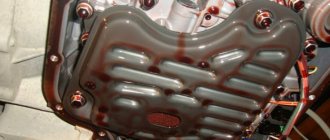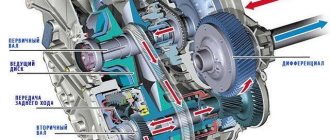Checking the oil level in the Honda Fit and Honda Jazz variator
1 launch of Fit after replacing CVT filters
Based on this, it is not recommended to perform a complete hardware oil change in the Honda Fit variator. Honda fit variator operation Video:
Hi all! Today I decided to write detailed instructions for changing the oil in a Honda Fit variator (Honda...
Without regret, throw away the old rubber seal ring for the plug; it is disposable. Wipe the cork several times with a clean rag to remove any shavings.
The replacement itself will cost much less. You can compare the old oil with the new one - you will definitely notice the difference. Changing the oil in the Honda Fit variator
Based on this, it is not recommended to perform a complete hardware oil change in the Honda Fit variator.
Especially on cars with high mileage. This is due to the fact that during operation, various deposits form inside the variator, which can be washed away during replacement under pressure.
How much oil to pour into the variator of a Honda Fit car
First generation GD, 2001-2007
The first generation Fit replaced the City model. It was a five-door hatchback with a high roof, which made it look like a family compact van. The car received a 1.3-liter L13A engine in combination with a CVT, as well as front-wheel drive or all-wheel drive. With a body length of only 3800 mm, the Fit was quite spacious thanks to the high roof. Honda engineers have implemented original design solutions in the compact van, such as a fuel tank under the front seats, as well as a Multi Matic S continuously variable transmission with an economical operating mode. The steering mechanism was equipped with an electric power steering with a processor, which made it possible to change the steering force depending on operating conditions. The compact van was also equipped with ABS, EBD and Brake Assist systems. The most expensive versions of the Fit had all-wheel drive and a 110-horsepower engine.
Also read: Oil for Mitsubishi Outlander XL variator
CVT oil: volume – 4.5 liters (13.5 liters – full replacement)
Second generation GE/GP, 2007-2013
The second generation fit retained the design of its predecessor with minimal modifications. The car became larger, and from a design point of view, the biggest changes affected the front end, which looked stylish due to enlarged headlights, a contoured hood and an aerodynamic bumper. The rear has also become more streamlined, but not at the expense of interior space, as the wheelbase has increased to 2500 mm (previously it was 2450 mm). The interior has been upgraded and new options have been added. The compact van received three types of transmission - in addition to manual transmission and CVT, a 5-speed automatic was also available. Engines are 1.3 and 1.5 liter petrol (100-120 hp), equipped with an i-VTEC system.
CVT oil: volume – 4.5 liters (13.5 liters – full replacement)
Third generation GP/GK, 2013-2019
The third generation of Fit saw major changes in design and construction. Thus, the car received a more dynamic and streamlined body, which is why the Fit’s target audience expanded significantly: from now on, the car attracted not only family people, but also a youth audience. Despite the short hood, the car looked stylish and had a coupe-like silhouette, even despite the previous roof height of 1525-1550 mm (depending on the version). The compact van is based on a new platform, the peculiarity of which is the wide possibilities for transforming the interior. The interior design features higher quality finishes and “secret” places to store small items. The 3rd generation Fit was available with upgraded engines of 1.3-1.5 liters (100-132 hp). The model also received a hybrid powertrain for the first time, as well as a seven-speed robotic gearbox with two clutches. Basic versions were still equipped with a manual transmission or a CVT.
CVT oil: volume – 4.5 liters (13.5 liters – full replacement)
Also read: Automatic transmission oil Honda Stream
Fourth generation GR, from 2019
The fourth generation fit retained the single-volume layout and silhouette, but the design became more minimalistic. In general, the compact van has lost its sporty lines in the front part of the body and has become similar to a typical single-volume car. When viewed from the side, you can pay attention to the new design of the side window, and from the front the car stands out with large LED headlights. To move even further away from the sporty image of its predecessor, the manufacturer has equipped the Fit with a cross-version of the Crosstar, which is distinguished by body kits made of unpainted plastic and larger 16-inch tires. This version also features roof rails and other attributes typical for an SUV. Basic versions of the Fit have front-wheel drive and are equipped with a 1.3-liter engine producing 98 hp. s., working with a variator. There is also an all-wheel drive hybrid version with similar power, based on a 1.5-liter engine. All trim levels are equipped with a CVT.
CVT oil: volume – 4.5 liters (13.5 liters – full replacement)
Procedure for changing the oil in a Honda Fit variator
Preparation for changing the oil in the Honda Fit variator includes the following steps:
- Determining the level of transmission lubrication (using a dipstick);
- Placing the car on a stable horizontal platform;
- Preparing the necessary tools: Pliers and a set of screwdrivers;
- Keys for working with drain plugs;
- Thick gloves;
- Synthetic wipes for car parts care;
- Buckets, cans or other containers for disposal of used oil;
- Funnel for pouring in new gear lubricant.
The peculiarity of changing the oil in a Honda Jazz variator is that in no case should you drain the used fluid from the gearbox if the car’s engine is not allowed to cool. Transmission lubricant heats up to a temperature of 120 degrees Celsius. If the liquid is not allowed to cool, serious burns may occur.
The procedure for replacing transmission lubricant in the Honda Fit variator is carried out in 2 stages:
- Draining used technical fluid;
- Filling the unit with new lubricant.
Let's talk in more detail about each of the points mentioned above.
Oil drain
Many car enthusiasts prefer to take care of their car systems themselves. But how to properly drain the oil from a Honda Fit CVT? Step-by-step instructions are presented below:
- The functional mudguard is removed;
- Place the drain container directly under the vehicle's CVT transmission;
- The variator drain plug is unscrewed;
- The spent technical fluid is drained into prepared containers.
It is important to take into account that transmission lubricant has a fairly dense consistency, so it will not leak out quickly. You should not rush and attempt to accelerate the natural release of the used technical substance.
Flushing the variator
Flushing the Honda Jazz variator is not a mandatory procedure when changing the technical fluid in the gearbox. Moreover, it is not recommended to flush the system yourself due to the fragility and complexity of its elements. The car owner should contact qualified employees of the nearest Special Service Station (STS). The work process of a service station employee, or rather his actions step by step, is described below:
- Placing the car in a horizontal suspended position;
- Adding the contents of 1 can of flushing agent to the recycled technical liquid;
- The engine starts for a time calculated by the employee himself;
- The engine is turned off and the flush is drained along with the used transmission lubricant;
- New transmission lubricant is poured into the variator hole.
The presence of an unqualified car owner during this procedure is excluded.
Underfilling or overfilling of oil in the variator - consequences
Operating a CVT with insufficient oil level can lead to serious damage. Of course, if there is a lack of fluid, the transmission can automatically go into neutral mode. But in any case, metal particles will pass through the oil pump.
Metal shavings on the variator tray
In the future, the pump may become unusable, followed by the variator. And it is unknown when the breakdown was discovered. It happens that the pump breaks down after just a few months, and the box is replaced under warranty. But quite often the mechanism is damaged after a few years, when the warranty period expires.
After checking, it may turn out that the fluid does not reach the required level. In this case, it is necessary to add oil and not operate the gearbox in this condition. Otherwise, it may require repairs or fail in the future. When replaced, the cost of a new CVT will be more than 100 thousand rubles. It is necessary to top up even with the slightest deviation of 2-3 millimeters.
With a warmed-up variator, the acceptable parameter is a level 1 millimeter above the upper mark. If the amount of liquid is greatly exceeded, it will begin to foam. In this case, when checking, foam will be detected on the dipstick. It is better to drain the excess, otherwise the problems described below in the operation of the car are possible.
Foamed oil in the gearbox - bubbles are visible on the dipstick
When standing with the brake on in mode D, a sharp drop in revolutions is observed. Then, after the click, the speed increases again. Then they fall again, and everything starts again. When trying to move, there will be a strong jerk forward. Only draining the excess oil will completely get rid of the problem.
The reason for exceeding the normal level by several centimeters may be the ingress of antifreeze. This problem occurs when the radiator is damaged. With this breakdown, the liquid is often colored, and slipping may occur when the speed increases.
Don't be alarmed if there is too much oil, the problem is easy to solve. It is enough to take the hose from the dropper and connect it to the syringe. Using this device it will be easy to pump out excess. It is also important to ensure that no dirt gets on the dipstick. The slightest speck will act as an abrasive and gradually destroy the mechanism.
What kind of oil should I use and how much?
Owners of a Honda Jazz car fill the engine with mainly oils with a viscosity of 0W-30 and 5W-30. The last option is used more often.
For Honda cars, there is an original oil that is recommended for use by official dealers and sellers - Honda 5W-30. However, buying a brand is an expensive business, so you can take any more or less normal company on the market.
The amount of oil needed is positioned for each specific engine, its configuration and power.
Engine / Oil quantity
1.3 L13A1 - 3.6 l; 1.2 L12A1 - 3.6 l; 1.2 2V - 3.5 l;
Do not forget that in addition to the lubricating fluid itself, you also need to change the cleaning filter or filter element.
Honda CVT - advantageous features
The main reason why a car with a CVT gearbox is chosen is reliability. The box was created using proven technologies using high-quality materials. It should be noted the increased operating life of the variator. Its average resource is 200,000 km.
If there is insufficient fuel, vibration will occur. In addition to this, vehicles will accelerate worse. If there is an excess of oil, changing gears will be difficult. The presence of extraneous knocking noises when changing gears is evidence that there is an oil leak in the car system. The CVT is negatively affected by driving when frequent sharp braking occurs.
Let's get started
It is important to remember that changing the oil should only be done when the car is warm. It is believed that much more hot oil will spill out than in cool mode. In addition, there is a high probability that almost all the metal shavings and other deposits will come out along with the heated oil. To warm up the engine to 60-70 degrees, it is enough to drive around the city for 10-15 kilometers, allowing for frequent traffic light stops and gas changes. Then you can proceed to the procedure, which consists of the following steps:
How to choose the right oil for the Honda Fit variator?
All transmission lubricants for cars are divided into:
- Original - substances created by the same manufacturer as the vehicle itself;
- Analog - produced by third-party companies, but suitable for the Honda Fit CVT in all respects.
The main original and available types of oils intended for the Honda Fit CVT transmission are presented below:
- Honda Ultra HMMF (Honda Multi Matic Fluid) is the most suitable brand of oil for the Honda Fit variator, sold in cans and buckets of 4 and 20 liters. The undoubted advantage of this particular transmission lubricant is that it is original in relation to the brand of car in question.
- Honda CVT-F (Continuously Variable Transmission Fluid) is an American-made analogue of HMMF. This substance is slightly inferior in its characteristics to Honda Multi Matic Fluid, but it is used by motorists no less often than the original mentioned above.
The recommended analogue oils for the Honda Fit variator are Idemitsu Extreme CVTF and Aisin CVT CFEX. However, if it is possible to purchase an original technical fluid, it is better to give preference to it.
Selecting transmission oil
The car will work for a long time if you carry out diagnostics and change the oil in a timely manner. What kind of oil to pour into the Honda Fit variator? For Honda Fit, you should use original transmission oil (CVT-F / HMMF). This fluid is intended exclusively for CVTs. It should be noted that they are reasonably priced. When choosing analogues, there is a risk of reducing the working capacity of the gearbox. There is a danger in using this oil in an automatic transmission.
The classic Honda Fit requires 3 quarts of transmission fluid. With each complete change of fuel in the variator, it is recommended to change the filters related to the gearbox. Changing the oil in the Honda Fit variator, done in a timely manner, will delay the need for a major overhaul of the gearbox.
Practical advice on choosing oil in a Honda automatic transmission
Car manufacturer Honda designs and manufactures its own vehicles. Together with the machine, the company's engineers have developed special additives that they add to the oil. Therefore, you should use the original oil to change the fluid.
Full and partial oil change in automatic transmission Honda Accord 7
If a car owner buys a regular Idemitsu ATF, a concern that develops lubricant specifically for Honda, then he will not find these additives in it. Since they are added only at the special request of the company.
What kind of transmission fluid do you buy and pour into your car? Write in the comments.
Original oil
You can see what original automatic transmission oil is in the automatic transmission and for which vehicles it is suitable in the table.
| Lubricant type | Car modification | Automatic transmission type | Quantity (l) |
| Honda ATF Z 1 (No. 08266-99904) | Honda CR-V | Machine | 4 |
| Honda HMMF Ultra (No. 08260-99904) | Civic | Variable speed drive | 4 |
| ATF Variable | Honda Fit, Honda Jazz | Variable speed drive | 1 |
Attention! I do not recommend using oils based on Dexron III. If you see this inscription on the dipstick, then know that it means that you need to fill it in order to get to the service station. Since this type of lubricant at elevated temperatures turns into a liquid that only vaguely resembles a lubricant.
The manufacturer also advises using ATF DW1 oil only for vehicles younger than 2011.
Analogs
Analogues of the original lubricating fluid in a Honda automatic transmission include the following oils:
- Honda Dual Pump Fluid DPF II (No. 082009007). For use in the US market only. This type of lubricant has excellent protective properties against wear of mechanical parts at both high and low temperatures;
- Honda VTM 4 (No. 082009003). Used on European Honda Pilot cars. Also used for filling into transfer case.
ATF DW 1 is a synthetic oil and is recommended for use only in machines that are prepared to operate on synthetics. This transmission fluid is considered an improved version of ATF Z1. Therefore, it is recommended for cars manufactured in 2011–….
What have you heard about the above Honda oils? Do you use any of them?
Changing the oil in the variator Honda Fit and Honda Jazz :: OILS-MARKET.RU
Hi all! Today I decided to write detailed instructions for changing the oil in the Honda Fit and Jazz variator. We have already published material on the website on the correct selection of oil for the Honda Fit variator. In the article I told you what kind of oil can be poured into the variator. We looked at original oils, and also did not forget about analogues. In general, if you haven’t read it, I recommend you read it. And today I decided to expand the old article a little and write about a DIY replacement.
Modern CVTs are fairly reliable car components. But reliability itself consists of careful attitude and timely service. It is important not only to choose the recommended fluid, but also to change it correctly. Due to design features, the Honda Fit CVT filter is located inside the box. Therefore, without a complete analysis it is impossible to get to it. Most Honda Fit cars are additionally equipped with an external automatic transmission filter, which is similar in appearance to the engine oil filter. It can be replaced without problems. Based on this, it is not recommended to perform a complete hardware oil change in the Honda Fit variator. Especially on cars with high mileage. This is due to the fact that during operation, various deposits form inside the variator, which can be washed away during replacement under pressure. This will cause clogging of the variator filter, which will undoubtedly affect its operation. And after that you will have to completely disassemble the box.
For Honda Fit cars, it is recommended to perform a partial replacement at a short mileage interval, and then repeat the replacement again. This way most of the liquid will be replaced. The replacement itself will cost much less. And the probability of “killing” the variator in this case will be extremely low.
Instructions for partial oil change in the Honda Fit variator
Important!!! All work is performed on a fully warmed up engine.
1. The first thing to do is gain access to the underside of the car. This means that the car needs to be driven onto a pit, overpass or lift. In extreme cases, you can get by with a jack. This is up to you. It all depends on your imagination. The main thing is not to forget about safety.
2. Remove the engine protection, if installed.
3. Unscrew the drain bolt as shown in the photo below.
4. Drain the old ATF into a previously prepared container. A 5L PET bottle with a funnel is perfect here. About 4 liters of transmission fluid should drain from the box.
5. Screw the drain bolt into place. The drain bolt has a built-in magnet, so it should be washed before installation.
6. New oil is poured into the hole in the variator dipstick. For convenience, it is better to use a funnel with a narrow spout and a small extension hose. This is also a matter of fantasy. The process is not important, the end result is important. And it is important for us that the new oil ends up inside the Honda Fit variator.
Important!!! Dirt and other foreign particles should not get into the variator through the dipstick hole. Always keep it clean!
7. It is better to measure the volume of drained oil before adding new oil. And pour exactly the same amount into the box. Then warm up the variator and check the level.
Checking the oil level in the Honda Fit variator
You can check the oil in the Honda Fit variator using a dipstick. (In the figure below indicated by the letter A)
To do this, it is necessary to warm up the engine to operating temperature. With the engine running, go through all the variator positions one by one with a slight delay. After which the engine will turn off. We take out the dipstick and wipe off the oil with a lint-free cloth. Then insert the dipstick all the way and immediately pull it out. The oil level should be between the minimum and maximum marks.
That's all. Now you know how to change the oil in a Honda Fit variator yourself, and also quickly and easily check the fluid level in the box. The only thing I would like to add is the timing of replacement. It is better to change the oil in the Fit variator at least once every 45,000 km. And if the car is used in difficult conditions, then the interval should be reduced to 25-30 thousand km. Follow this condition and then your car’s variator will serve you faithfully for many years! See you again!
Checking the Oil Level in the Honda Fit CVT
Honda Fit. changing the oil in the variator
Before buying a car, many people try to choose a model that suits them perfectly, including technical specifications. Some prefer automatic transmission, some prefer manual despite the highest fuel consumption, others prefer CVT
, which combines the advantages of the first 2 gearboxes. Its advantages include low fuel consumption, no jerking when changing gears and the ability to transmit more torque.
Pros and cons of MPA
The first solid waste produced was not particularly reliable, but after some time the quality of the products improved significantly thanks to the competent use of modern equipment, technologies and materials. In addition, the oil used for these gearboxes has been upgraded, resulting in longer service life. In general, this is considered a disadvantage: it needs to be changed more often than manual and automatic transmissions, but the complete set makes a difference in comfort and fuel economy.
Modern Honda Fit CVT models have a service life of 200,000 km without any defects, but this gearbox is guaranteed by timely oil changes and careful handling. According to the technical documentation of the car, the special fluid in the variator should be replaced every 20-30 thousand km, in other words, after one engine oil change. The downside is the lack of cost savings, but the health of the Honda Fit depends on timely changes.
The downside of the KVT is the difficulty of going uphill: if you're on a hill above 40 degrees, the HRT will jump around a lot as the engine speed increases. The Honda Fit should not be running for a long time in this mode: this may become a prerequisite for burning out the transmission. Balanced option. carefully go down the flat section of the road and go up the hill from acceleration. In fact, the extra couple of minutes spent on the road will not make a strict difference, but you will have to pay a lot of money to fix the CVT.
How to determine the condition of the variator when buying a car
When buying a used car, it is better to examine the condition of the transmission, especially if it is a CVT type. An illuminated variator is not difficult to identify. the accelerator pedal is fully depressed and the behavior of the tachometer needle is immediately monitored. Increasing speed up to 4 thousand and maintaining vehicle speed up to 50 km/h is an excellent opportunity to wear out the wheels of the variator. During normal operation of the variator, the tachometer needle will rise at a speed of over 5 thousand rpm at a speed of 80 km/h, in addition, the engine should not jerk or spin when braking and accelerating. If this is not excluded or the tachometer needle is constantly jumping, it is possible that the expanding and contracting discs have suffered scratches and impacts during which the belt was pinched.
check the oil level in the variator
The quality and duration of operation of at least one mechanism depends almost not only on the production materials, but also on the environment in which it operates. To ensure there is no doubt that our customer is left with the components and mechanisms of a Honda Fit variant that works well, it is often enough to check the lubrication levels. This is done quite simply, the process does not select a long period.
Signs of Low Oil Level
A low level of special fluid in the box with continuous adjustment of the Honda Fit affects the workplace of the entire dosing system and requires urgent replacement of lubricating water. This is determined by the following features:
- Maximum engine vibration at idle;
- Initially the machine is closed;
- Slow vehicle acceleration;
- The car doesn't move.
Signs of high oil level in the variator
Often, of course, you are faced with a situation where your Honda Fit has a very low oil level. The diagnosis is made based on the following criteria:
What about scratches?
We are constantly asked what liquid glass is and how much auto advertising is currently on the economic market. In the end, they decided to test in practice how true this was. Say yes, we used 3 tools. One medicine turned out to be such; after application, the burned spot remained in this position. The second agent in the application showed absolutely no effect.
The third instrument SILANE GUARD, at the beginning, also felt that there would be no effect. unfortunately, when the decision was delayed for a couple of minutes, the effect was ok. Of course, few things remain as perfect for our client as advertised.
We had a discussion with local 100, they said the money had been sold, it was valid but should only be used as advertised. And not the way you like it.
- Strongly shifting gears;
- In the neutral position of the variator, the car continues to move forward;
- Do you have any problems during the operation of the variator.
Honda Jazz shakes when accelerating
When checking the oil level in a Honda CVT, the instrument must be carefully monitored to prevent foreign particles or particles from entering the probe or tube.
Level checked
The fluid in the Honda Fit CVT looks like this:
- The car is driving on a flat surface.
- The engine starts and runs until the cooling system starts. The fan cannot be restarted, in which case the level will be higher than it actually was during the test.
- It is recommended to measure the level for 60-90 seconds so that the oil does not cool down and its volume does not decrease.
- The bar is removed and after cleaning it is again immersed in the hole.
Which oil is suitable for Honda Fit CVT?
The first generation Honda Fit transmission with constant change uses only original oils. HMMF or CVTF, which are the same HMMF that are only available in the US and European markets. It is better not to use other special liquids for HRT.
Special HMMF fluids (CVTF) were created by Honda, and there are no other analogues to these oils. Only Honda has the production rights, they are not transferred to any other company, so only special specialty fluids must be used for this brand's CVT.
HMMF (CVTF) includes not only cooling additives, but also special materials that help maintain fluid balance. In fact, the same fluid can simultaneously dissipate heat, lubricate friction parts, and increase friction between the pulley and belt to prevent one from slipping into the other.
Let me change the oil
The parameters and capabilities of special Honda fluids begin to “age” over time, which can lead to belt slippage and other malfunctions. The characteristics necessary for normal operation of the variator are maintained only by fresh fluid, so it must be replaced regularly.
How to properly maintain a variator
Similar articles
- Honda regulations
- How to properly flush the engine
- Honda K-series engines (K20A, K24A). Characteristics, applicability, reliability, ability...
So, for Honda CVT * only oils from Honda are used called HMMF (Honda Multi Matic Fluid) or CVTF (the same HMMF, but for the European and American markets). No other oil, no matter how wonderful its name, is suitable for CVT Honda!
Left: HMMF (Japanese Domestic Market). Right: CVTF (American market).
There is no “complete replacement” or “complete analogue” of HMMF special fluid other than Honda CVTF special fluid. Honda did not transfer production rights to any company, neither Castrol, nor Mobil, nor Yokki. The can of these fluids may say that they “meet Honda requirements,” but they do not have a RECOMMENDATION for use in Honda components.
Please pay special attention to this as the HMMF (CVTF) has been specifically designed for the unique Honda Multi Matic (HMM) system with the already mentioned friction discs. The history of the origin of HMMF is not a secret - it is a continuation of the development of ATF Z1, which, as we already know, is the successor to the “classic” Dexron II. On early Honda CVTs (Civic cars in the EK3, HR-V, Integra SJ body), ATF Z1 is even written on the gearbox dipsticks, but this mark is the same story as with the Dexron II inscription on automatic transmissions before 1996. The use of ATF Z1 is permissible on CVTs before 2000, but for a short time. On later cars, driving on ATF Z1 is generally unacceptable.
The reason for this limitation lies in the chemical properties of HMMF (CVTF) and the fundamental difference between the Honda CVT and all other similar designs. We have already talked about the feature of HMM, but what is so special about HMMF (CVTF)?
The fact is that the unique composition of HMMF (CVTF) contains, in addition to a package of cooling additives, a special material that allows the fluid to balance in a working variator between lubricating and friction-increasing parameters! That is, the same liquid must simultaneously act as a heat sink, lubricant, and friction amplifier between the belt and pulley to avoid slippage. Other liquids are simply not capable of this!
Now about the replacement period. It should be remembered that aging of HMMF fluid leads to a decrease in its ability, which ultimately leads to belt slippage, and so on. Only fresh fluid can maintain all the necessary parameters at normal levels, so under no circumstances should you delay replacing it.
Determining the aging of HMMF (CVTF) “by eye” is also unrealistic, as in the case of ATF Z1. If the “master” says that the liquid is still clean and transparent and does not need to be replaced, then he is not a professional. Only an expensive analysis using special equipment, the cost of which can exceed all reasonable limits, can tell you about the quality of the liquid. If you doubt the quality of the fluid poured into your Honda's variator, it is better, easier and cheaper to change it.
Large variable speed filter installed under the pan.
To replace HMMF you will only need about five liters of fluid, and not twelve, as they call it at some service stations. In principle, flushing is not even contraindicated for the first Honda CVTs, since when replacing the fluid it is necessary to change two filters installed in the box - one in the sump (HR-V) or near the radiator (Civic EU, the second on the CVT body itself. But flushing is better do not use - partial replacement even in this case will be more correct.Also, you may need a variator pan gasket, although it is made of cardboard.
The process of replacing special fluid in Honda CVTs with a sump is described in detail here .
On later CVTs (Fit), there is no pan, and the replacement process is reduced to a partial oil change, as is the case with a conventional automatic transmission. Some models may have an additional remote filter, similar to the one found on the Civic, or, conversely, located in the box housing.
In all cases, the amount of oil drained and filled will be approximately the same - from 3.8 (FIT) to 4.6 liters (HR-V). It is always better to take a little more oil, since having it is always more convenient than not having it. If a standard Japanese can of HMMF is enough for the Honda Fit, then for all other CVTs you will have to look for another additional liter. Although it won't be superfluous. Many people forget, for example, that when removing drives to replace boots, a small amount of oil is drained, which must be restored after the operation is completed. That's when the remaining oil will come in handy.
To replace 85-90% of the fluid in a heavily worn variator, you, as in the case of an automatic transmission, will have to repeat the oil change operation after 200-300 km, however, most often this is not required. After the first replacement, it becomes clear whether the variator is alive, or whether all procedures are already too late.
If, nevertheless, the CVT cannot be helped by replacing the fluid, all that remains is to repair it, and here one can only sympathize with the owner of the variator. The problem is that spare parts for the CVT unit are not available for sale in any form other than the assembled unit. In terms of cost, the unit is sometimes more expensive than the cost of the entire car if it was bought secondhand. There are precedents when it was possible to find the actual belt, with the replacement of which all problems disappear, but this exception, one might say, was just lucky.
So Russian masters are absolutely right when they say that the variator, in the event of a breakdown, is absolutely beyond repair. There are simply no spare parts for it. Many, if faced with such a problem, tend to replace the entire box with a contract one, i.e. used. Unfortunately, unlike a conventional automatic transmission, where replacement is acceptable because its service life is much longer, in the case of a CVT it turns out to be a real lottery. There is a chance of winning, but in this case you will simply receive a working car, which is what you actually paid money for. A loss will mean a definite loss of funds - one installation of a checkpoint costs a lot of money, and after a month the slippage will begin again.
It’s also worth mentioning which brands of Honda have a CVT. Often, although not always, it is found on Civics in the EK3, EU1, ES1 body, on all HR-Vs, except with manual transmission, on almost all Fit (Jazz).
There are particularly interesting solutions that are truly exclusive. The court "tuning studio" of Honda, with modifications to the Honda Fit. So among its products there is a unique Fit Mugen, with a turbocharged (!!) L15A engine and all on the same CVT. Let's hope that the life of the variator on this “bullet” will be as long as it looks impressive, and “shoots” even more impressively!
In general, any car after 1998 with an engine capacity of up to 1600 cc may well have a CVT on board. On cars with large volumes, CVTs are not installed for the same reason - the complexity of combination and unreliability of the unit. However, technology does not stand still. An exception to this rule is the Honda Odyssey - a minivan with an engine capacity of 2400 cc, in the RB1 body, except for the Absolute (and also M) configuration. On these large cars with a powerful engine, in addition to the above-mentioned equipment, there is a CVT gearbox.
Summing up the conversation about the variator, it is necessary to emphasize the following - the variator gearbox is a reliable, promising unit that still requires some care and attention. Fluid replacement, always with filters (if available), should be done regularly, every 35,000 - 40,000 km. If filters are not available, a partial replacement is performed, as is the case with a conventional automatic transmission. If you have a CVT, sudden acceleration, braking, and long-term travel at speeds of more than 120 km/h are strictly not recommended.
*Second-generation Honda CVTs include transmissions installed on Honda Accord (variables since 2013) and Honda Fit (variables since 2015). In this case, another technical fluid is used - HCF-2.
To determine the required type of fluid used in the automatic transmission of your car, we recommend that you carefully study the vehicle’s operating instructions before repair work.
Hondavodam.ru
If you find an error, please select a piece of text and press Ctrl+Enter.
More interesting articles
How to change the oil in a Honda Fit CVT?
Honda Fit CVT automatic transmission Some people prefer to perform this procedure at a service station, but it is so simple that after reading this article and watching the video, you can handle it yourself in just half an hour.
Replacement instructions
Attention! During all oil changes, be careful that grains of sand and dirt do not accidentally get on the dipstick or inside the box. Otherwise, when they get into the system, they begin to act like sandpaper and can damage it.
What kind of oil should I use?
Original HMMF grease
Manufacturers and experts recommend pouring original CVT-F and HMMF oil.
In no case and under no circumstances should you pour oil for classic automatic transmissions, since it has different characteristics, and within a few weeks the Honda Fiat CVT will be disabled.
To change the 1st generation Honda Fit lubricant you will need approximately 3.2 liters of fluid, and for the 2nd generation - 3.0 liters.
Tools
Since the replacement procedure is simple, you will need a minimum of tools, which every car enthusiast probably has in the garage:
- funnel;
- hose;
- new sealing washer;
- new lubricant for the Honda Fit variator;
- keys;
- rags;
- gloves.
Stages
- To perform work on changing the Honda Fit gearbox oil, the car must be lifted on a lift, placed on an overpass or inspection hole.
- Start the car engine and wait until the fan turns on.
- We turn off the engine.
- We place the car on an overpass, pit or lift; if this is not possible, then lift the front of the car.
- For ease of work, it is necessary to dismantle the shield that protects from dirt.
- Unscrew the plug to drain fluid from the variator. Unscrew the bolt
- Drain the grease. Drain the grease
- Lubricate and install the sealing washer.
- Screw the drain plug into the drain hole.
- Pull out the dipstick (you can easily find it by the yellow handle).
- Using a funnel and a guide tube, pour transmission oil for the variator into the box. Pour new fluid through the funnel
- Insert the dipstick into its original place.
- Check the level, if there is not enough, top it up.
- Replace the mudguard.
As you can see, the change procedure is simple and within the capabilities of a novice car owner.
This type of transmission is one of the most comfortable available today and, if you do everything right, you will get a lot of pleasant driving sensations.
What oil should I use and how much will I need?
The automaker and experienced technicians advise using only original CVT-F and HMMF oils, which are affordable, so there is no point in trying to find analogues. Under no circumstances should you fill CVT gearboxes with lubricants intended for classic transmissions, as lubricants differ in characteristics. If you make a mistake and fill the variator with regular gearbox oil, the transmission will fail within 1-2 weeks or even earlier.
To change the oil in the first generation Honda Fit variator you will need a little more than 3 liters of lubricant, and for the second generation exactly 3 liters will be enough.
Possible variator malfunctions
Appearance of the Honda Fit variator
If you prefer to drive without sudden accelerations and stops, the optimal solution is to buy a Honda Fit with CVT. A variator is a type of high-speed gearbox that ensures the smooth running of a vehicle. This unit allows you to save on fuel consumption.
Let's list the reasons for CVT problems:
- low quality oil was used;
- filter wear;
- aggressive driving style;
- There were often sudden slowdowns.
The main signs of damage to the variator are: vibrations, knocking, hum. In case of any of the listed manifestations, it is necessary to conduct a full diagnosis of the vehicle. Repairing a CVT, as well as an automatic transmission, is an expensive procedure. Taking this into account, it should be serviced in a timely manner.
The CVT cushion is one of the weak points of the Honda Fit. The average resource of this spare part reaches 50,000 km. If it breaks, the box may start to kick. In this case, you should check the spark plugs and coil.
Why is the variator humming? The main reason for this is bearing failure. The working life of these components and other gearbox mechanisms depends on the driving style of the car owner. Also, if the variator hums, for example, while standing in a traffic jam, the airbag and oil level must be checked.
Cost of new and used gearboxes for Honda Fit
| Transmission type (manual, automatic, variator) | Price in rubles New | Price in rubles Major repairs |
| Automatic transmission | From 184000 | From 92500. |
| Manual transmission | From 179600 | From 76200 |
| Variable speed drive | From 181900 | From 81500 |
| *price indicated as of April 2022 | ||
The cost of the transmission depends on the region of purchase of parts, spare parts, and components. When purchasing spare parts online, the cost is cheaper.
How to check the oil level in a Honda Fit CVT
Checking the oil level in the Honda Fit variator is done by measuring with a plastic dipstick located on the box body in the engine compartment. To carry out this procedure, it is necessary to remove the dipstick from a special wire in the crankcase and, in accordance with the risks located on this part, determine the current level. If this indicator decreases, it is necessary to urgently top up or go to a specialized service to troubleshoot the entire system.
When to change the oil
The frequency of oil changes in the variator of a Honda Jazz car is 40-50 thousand km. The most accurate lubricant change interval depends on operating conditions - road quality, weather conditions and driving style. For example, frequent driving in dusty or slushy areas, as well as sudden starts and stops, towing heavy loads and traffic lights may cause you to change your oil earlier. Signs of deterioration in the quality of the fluid include cloudiness due to the presence of metal shavings or wear products in the form of sediment, as well as insufficient levels or malfunctions of the variator (howling, humming, jerking and twitching when the gas is pressed smoothly).
Why is it better to change the oil in a variator at a car service center?
To change the oil in the CVT variator, it is recommended to contact a car service center. This will eliminate errors when replacing. Also, experienced specialists will conduct transmission diagnostics to check the condition of the mechanism.
The need to contact a service center is due to the mandatory qualifications of the performers and the use of technical means. Considering the high cost of components (as well as the variator as a whole), failure of the box due to errors when changing the oil will be costly for the owner.
To ensure reliable operation of the Honda Fit CVT transmission, timely replacement of the lubricant is required. The owner must purchase original lubricant or an equivalent that exceeds the tolerances.
Honda N-WGN engine oil filter
Oil filter VIC C-809
Oil filter VIC C-809
Oil filter Vic DC-06
The filter has a double filter element. Half of the oil passes through a 20 micron filter and the other half through a 10 micron filter. This technology allows improving oil purification without losing oil pressure.
Vic DC-06
Oil filter MANN W610/6
MANN W610/6
Oil filter Nitto 4HM-113
Preparing to change the oil in the variator
First you need to check the current level of the remaining fluid. To do this you need to take the following steps:
- Place the car on an observation platform with access under the bottom of the car
- Turn on the engine, wait for the engine to warm up completely, then turn off the engine. Warming up is necessary so that the oil temperature in the gearbox rises to 50-60 degrees
- Pull the dipstick out of the filler hole. This dipstick is used to check the level of the filled liquid. Wipe the dipstick with a napkin, then insert it back into the hole. Pull it out again and look at the volume: the trace of oil should not exceed the Max mark on the dipstick, or, conversely, be less than the Max and Min marks. In this case, the fluid can simply be added or drained if a complete oil change is not required.
Search
How to change the oil in the Honda Fit variator box?
Some motorists now believe that the gearbox is not reliable enough, but this is the wrong view. If you change your Honda Fit oil promptly and correctly, the myth will last for many years without any breakdowns.
frequency of changing the oil in the variator
The Honda Fit car manufacturer advises changing the oil in the variator every 45 thousand kilometers, unfortunately, we recommend doing this more often. Our cars are operated according to rather terrible criteria, so it is best to reduce the time for replacing all fluids in the systems by about one and a half times.
Some people order an oil change in a Honda CVT. Contact a specialized service center, but we will tell you how to do it without the help of other people at home. The procedure does not select a long period, but stores a certain amount of currency.
Sources
- https://AlanSpb.ru/dvigateli/honda-dzhaz-maslo-v-variator.html
- https://AutomobilGroup.ru/dvigatel/zamena-masla-dvigatele-khonda-foto-instruktsiya-pomenyat-motornoe-maslo/
- https://akki-carsh.ru/to/honda-fit-korobka-variator.html
- https://KrymShina.ru/marki/maslo-v-variator-fit.html
- https://VmyatynNet.ru/marki/honda-fit-maslo-v-akpp.html
- https://PrideSaratov.ru/dvigateli/zamena-masla-v-variatore-honda-dzhaz.html
- https://SpecTrSnub.ru/marki-dvigatelej/uroven-masla-v-variatore-honda-dzhaz.html
[collapse]
Conclusion
The readers were presented with the best transmission oils - the originals, as well as more affordable analogues. In any case, the final choice is up to the buyer. The main factors by which you should choose an oil are compliance with the parameters specified in the user manual. It is also advisable to fill in synthetic oil, without any additives or additives. The level of tolerance and viscosity must also correspond to the technical data set out in the passport. With original oils everything is clear - there is no doubt about their quality. As for oils with multi-approval, it can be clearly stated that such a liquid will definitely not harm the Honda Fit CVT, since it is suitable for HMMF approval.
View oil prices











